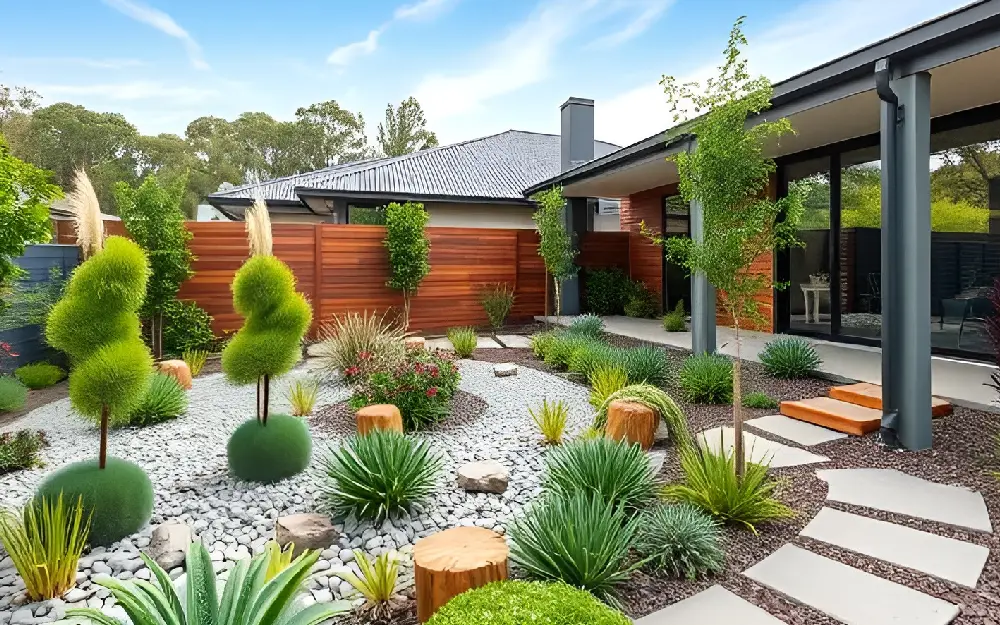
New Home Design Trends for Eco-Friendly Landscaping
As homeowners become more aware of the environmental impact of traditional landscaping practices, there’s a growing shift toward eco-friendly landscaping designs. Sustainable landscaping not only benefits the planet but also creates beautiful, low-maintenance outdoor spaces. If you're planning to build or renovate your home, incorporating these eco-friendly landscaping trends can help you reduce your carbon footprint while boosting your curb appeal. Let’s dive into the latest trends for eco-friendly home designs.
1. Native Plants Take Center Stage
One of the easiest ways to create an eco-friendly landscape is by using native plants. Native plants are well-adapted to the local climate, so they require less water, fertilizer, and pesticides to thrive. They also attract local wildlife, such as birds and butterflies, and help maintain biodiversity. Planting species that are native to your region reduces the need for water-heavy lawns and supports the local ecosystem.
2. Water Conservation with Drought-Tolerant Plants
Water scarcity is a growing concern in many parts of the world, especially in Australia. Homeowners are increasingly turning to drought-tolerant plants that need less water to thrive. Succulents, cacti, and other drought-resistant plants can be strategically placed in your garden, reducing the amount of water needed for landscaping upkeep. In addition, using mulch and ground covers helps retain moisture in the soil, further cutting down on the need for watering.
3. Rainwater Harvesting Systems
Rainwater harvesting is a smart and sustainable way to irrigate your garden. Installing a rainwater collection system, such as a rain barrel or a more advanced rainwater tank, allows you to collect runoff from your roof. This water can then be used to water your plants, reducing your reliance on municipal water systems and conserving precious resources.
4. Edible Gardens and Urban Farming
With more people prioritizing sustainability, edible gardens are becoming a staple in eco-friendly landscaping. Growing your own fruits, vegetables, and herbs not only provides you with fresh, local produce but also reduces your environmental impact by cutting down on food transportation. Raised garden beds, vertical gardens, and even hydroponic systems can help make the most of small spaces and encourage self-sufficiency.
5. Sustainable Materials for Hardscaping
When it comes to paths, patios, and retaining walls, sustainable materials are key to reducing the environmental impact of your landscaping. Look for options like recycled concrete, reclaimed wood, and natural stone that have a lower carbon footprint compared to traditional materials. Using permeable paving stones or gravel for walkways allows rainwater to filter into the ground, reducing stormwater runoff and promoting better drainage.
6. Solar-Powered Outdoor Lighting
Solar energy isn’t just for homes – it can also power your outdoor lighting. Solar-powered garden lights are an energy-efficient and eco-friendly way to illuminate your landscape. These lights are powered by the sun, so you won’t need to worry about energy bills or the environmental impact of traditional electric lighting. Plus, they add a beautiful, warm glow to your outdoor space without harming the planet.
7. Green Roofs and Living Walls
For those looking to push the envelope in eco-friendly landscaping, green roofs and living walls offer a stunning and sustainable option. Green roofs are covered in plants, providing insulation, reducing the urban heat island effect, and improving air quality. Living walls, or vertical gardens, can be installed on the sides of buildings, adding a touch of nature to urban environments while also helping to reduce energy consumption and improve insulation.
8. Electric Lawn Equipment
Traditional lawn equipment like gas-powered mowers and trimmers can contribute to air pollution and noise pollution. Many homeowners are now opting for electric or battery-operated lawn tools that are quieter, cleaner, and more energy-efficient. Electric mowers, trimmers, and blowers help reduce emissions and make lawn care more eco-friendly, all while still getting the job done.
9. Wildlife Habitats and Pollinator Gardens
Supporting local wildlife is an important part of eco-friendly landscaping. By planting pollinator-friendly plants such as lavender, sunflowers, and echinacea, you can attract bees, butterflies, and other essential pollinators. Installing birdhouses, bat boxes, or small water features can also provide habitats for local wildlife and encourage biodiversity in your garden.
10. Smart Irrigation Systems
A key element of eco-friendly landscaping is water conservation. Smart irrigation systems use weather data and moisture sensors to determine the optimal time and amount of water needed for your garden. These systems ensure that your plants receive just the right amount of water without wasting resources, making them a great addition to any sustainable landscape design.
Final Thoughts
As environmental concerns continue to grow, sustainable landscaping is no longer just a trend – it’s a necessary shift toward a greener, more responsible future. Whether you're planting native species, installing solar-powered lights, or incorporating edible gardens, there are countless ways to create a beautiful, eco-friendly landscape. By adopting these new home design trends for eco-friendly landscaping, you can reduce your environmental impact, enhance the beauty of your outdoor space, and contribute to a more sustainable world.
Let’s work together to make our homes and gardens a positive force for the planet!


